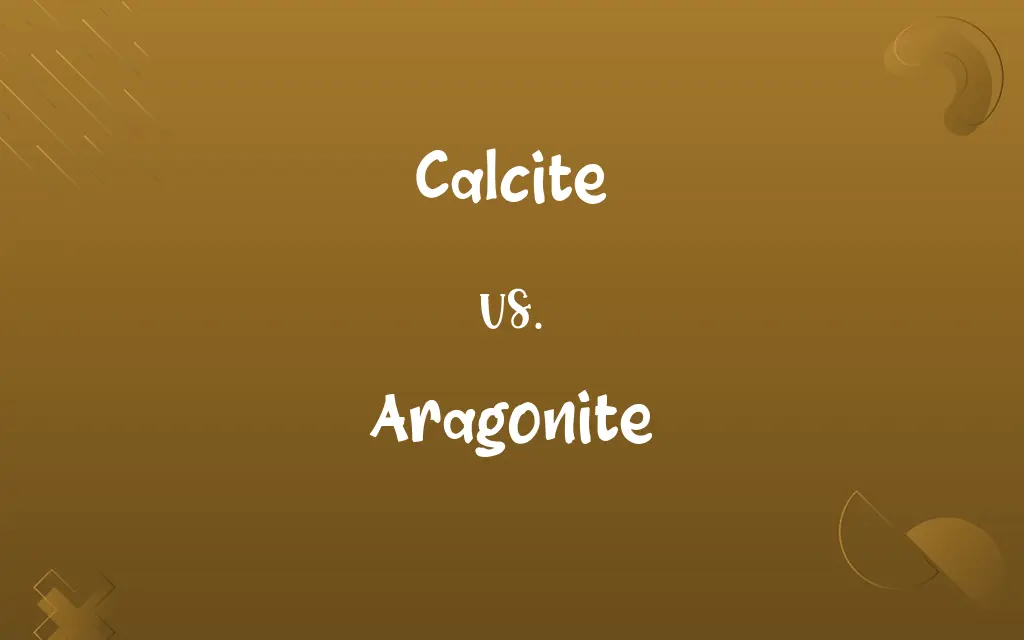Calcite vs. Aragonite: Know the Difference

By Shumaila Saeed || Updated on December 26, 2023
Calcite and Aragonite are both forms of calcium carbonate (CaCO3), differing in crystal structure; Calcite forms trigonal crystals, while Aragonite forms orthorhombic crystals.

Key Differences
Calcite and Aragonite are two different minerals composed primarily of calcium carbonate (CaCO3), but they differ in their crystallography. Calcite crystallizes in the trigonal system, forming stable, scalenohedral crystals. In contrast, Aragonite forms in the orthorhombic system, creating distinct, elongated, and columnar crystals. This difference in crystal structure affects their stability and formation conditions.
Shumaila Saeed
Dec 24, 2023
The formation conditions of Calcite and Aragonite vary significantly. Calcite is often formed in a broad range of temperatures and pressures, commonly found in sedimentary rocks like limestone and marble. Aragonite, however, is more likely to form in marine settings at higher pressures, often seen in mollusk shells and coral structures. This environmental preference is due to their distinct molecular arrangements.
Shumaila Saeed
Dec 24, 2023
When considering the stability of Calcite and Aragonite, Calcite is generally more stable at the Earth's surface conditions. Over geological timescales, Aragonite often transforms into Calcite, a process known as aragonite to calcite transformation. This transformation is influenced by factors like temperature and the presence of other minerals or organic materials.
Shumaila Saeed
Dec 24, 2023
In terms of applications, Calcite and Aragonite are used differently due to their properties. Calcite, being more stable and abundant, is widely used in the construction industry and in making lime for agriculture. Aragonite's unique crystal form finds its uses in jewelry and as an aquarium substrate due to its ability to buffer acidic water.
Shumaila Saeed
Dec 24, 2023
Lastly, the historical and cultural significance of Calcite and Aragonite varies. Calcite has been known and utilized since ancient times, being a major component of many historic structures and artifacts. Aragonite, while also historically significant, is particularly noted for its role in the formation of pearls and as a guide for understanding climate change through coral growth patterns.
Shumaila Saeed
Dec 24, 2023
ADVERTISEMENT
Comparison Chart
Formation Environment
Broad range, often terrestrial
Mainly marine environments
Shumaila Saeed
Dec 24, 2023
Stability
More stable at Earth’s surface conditions
Less stable, often transforms into Calcite
Shumaila Saeed
Dec 24, 2023
Historical Significance
Extensively used in ancient architecture
Significant in pearl formation and climate studies
Shumaila Saeed
Dec 24, 2023
ADVERTISEMENT
Calcite and Aragonite Definitions
Calcite
Calcite is a common naturally occurring calcium carbonate mineral, found in rocks like limestone and marble.
The marble statue, rich in calcite, shone brilliantly in the museum.
Shumaila Saeed
Dec 13, 2023
Aragonite
Aragonite is a crystalline form of calcium carbonate, often found in mollusk shells and coral.
The seashell, comprised mainly of aragonite, had a delicate yet sturdy structure.
Shumaila Saeed
Dec 13, 2023
Calcite
Calcite is a primary component of many sea shells and coral, contributing to marine biodiversity.
The coral reefs, composed largely of calcite, harbored a stunning array of marine life.
Shumaila Saeed
Dec 13, 2023
Aragonite
Aragonite is less stable at Earth’s surface conditions compared to calcite, often transforming into it over time.
The aragonite sample slowly transformed into calcite as it was exposed to the surface environment.
Shumaila Saeed
Dec 13, 2023
Calcite
Calcite has a trigonal crystal structure, forming a variety of shapes like rhombohedra.
The calcite crystals in the cave formed beautiful rhombohedral shapes.
Shumaila Saeed
Dec 13, 2023
ADVERTISEMENT
Aragonite
Aragonite plays a crucial role in understanding climate change through its presence in coral reefs.
Studying the aragonite in coral reefs helps scientists track historical climate patterns.
Shumaila Saeed
Dec 13, 2023
Calcite
Calcite reacts with acids to produce carbon dioxide, a property used in identifying this mineral.
When hydrochloric acid was applied, the calcite sample fizzed, indicating its presence.
Shumaila Saeed
Dec 13, 2023
Aragonite
Aragonite is known for its orthorhombic crystal system, forming elongated, prismatic crystals.
The aragonite specimen showcased its characteristic elongated crystals.
Shumaila Saeed
Dec 13, 2023
Calcite
Calcite is known for its high birefringence in optical applications, often used in polarizing microscopes.
Under the polarizing microscope, the calcite crystals displayed vibrant colors.
Shumaila Saeed
Dec 13, 2023
Aragonite
Aragonite is valued in jewelry for its distinct crystal shape and luster.
The aragonite necklace glistened with a unique brilliance, thanks to its crystal structure.
Shumaila Saeed
Dec 13, 2023
Calcite
A common crystalline form of natural calcium carbonate, CaCO3, that is the basic constituent of limestone, marble, and chalk. Also called calcspar.
Shumaila Saeed
Dec 13, 2023
Aragonite
An orthorhombic mineral form of crystalline calcium carbonate, dimorphic with calcite.
Shumaila Saeed
Dec 13, 2023
Calcite
(mineral) a very widely distributed crystalline form of calcium carbonate, CaCO3, found as limestone, chalk and marble
Shumaila Saeed
Dec 13, 2023
Aragonite
(mineral) An evaporite consisting of anhydrous calcium carbonate with the chemical formula CaCO3; it is dimorphous with calcite.
Shumaila Saeed
Dec 13, 2023
Calcite
Calcium carbonate, or carbonate of lime. It is rhombohedral in its crystallization, and thus distinguished from aragonite. It includes common limestone, chalk, and marble. Called also calc-spar and calcareous spar.
Shumaila Saeed
Dec 13, 2023
Aragonite
A mineral identical in composition with calcite or carbonate of lime, but differing from it in its crystalline form and some of its physical characters.
Shumaila Saeed
Dec 13, 2023
Calcite
A common mineral consisting of crystallized calcium carbonate; a major constituent of limestone
Shumaila Saeed
Dec 13, 2023
Aragonite
A mineral form of crystalline calcium carbonate; dimorphic with calcite
Shumaila Saeed
Dec 13, 2023
Repeatedly Asked Queries
Where is Calcite commonly found?
Calcite is found in a variety of geological settings including limestone, marble, and seashells.
Shumaila Saeed
Dec 24, 2023
What is Calcite?
Calcite is a common calcium carbonate mineral, often found in sedimentary rocks.
Shumaila Saeed
Dec 24, 2023
How do Calcite and Aragonite differ in crystal structure?
Calcite forms in a trigonal system, while Aragonite forms in an orthorhombic system.
Shumaila Saeed
Dec 24, 2023
Can Aragonite transform into Calcite?
Yes, Aragonite can transform into Calcite under certain conditions like temperature changes.
Shumaila Saeed
Dec 24, 2023
What are the uses of Calcite?
Calcite is used in construction, agriculture, and optical applications.
Shumaila Saeed
Dec 24, 2023
What are the uses of Aragonite?
Aragonite is used in jewelry, aquarium substrates, and in climate change studies.
Shumaila Saeed
Dec 24, 2023
What is Aragonite?
Aragonite is a form of calcium carbonate known for its distinct crystal structure and marine formation.
Shumaila Saeed
Dec 24, 2023
Where is Aragonite commonly found?
Aragonite is typically found in marine environments like mollusk shells and coral.
Shumaila Saeed
Dec 24, 2023
Is Calcite reactive to acid?
Yes, Calcite reacts with acids, releasing carbon dioxide.
Shumaila Saeed
Dec 24, 2023
How is Aragonite formed?
Aragonite typically forms in marine settings under high pressure.
Shumaila Saeed
Dec 24, 2023
What role does Aragonite play in climate research?
Aragonite in coral reefs is used to study past climate conditions.
Shumaila Saeed
Dec 24, 2023
Can Calcite be used in identifying rocks?
Yes, its presence and reactions are key in rock identification.
Shumaila Saeed
Dec 24, 2023
Why is Aragonite important in jewelry?
Its unique crystal form and luster make it desirable in jewelry making.
Shumaila Saeed
Dec 24, 2023
How does Calcite contribute to marine biodiversity?
Calcite is a major component of sea shells and coral, supporting marine ecosystems.
Shumaila Saeed
Dec 24, 2023
How is Calcite formed?
Calcite forms in various environments, often as a result of biological and geological processes.
Shumaila Saeed
Dec 24, 2023
Does Aragonite have any cultural significance?
Aragonite is notable for its role in the formation of pearls and historical climate understanding.
Shumaila Saeed
Dec 24, 2023
Is Aragonite reactive to acid?
Yes, like Calcite, Aragonite also reacts with acids.
Shumaila Saeed
Dec 24, 2023
What are the physical properties of Aragonite?
Aragonite is known for its elongated crystals, luster, and less stable structure compared to Calcite.
Shumaila Saeed
Dec 24, 2023
Does Calcite have any cultural significance?
Yes, it's been used historically in architecture and various cultural artifacts.
Shumaila Saeed
Dec 24, 2023
What are the physical properties of Calcite?
Calcite is characterized by its birefringence, various crystal shapes, and reaction to acids.
Shumaila Saeed
Dec 24, 2023
Share this page
Link for your blog / website
HTML
Link to share via messenger
About Author
Written by
Shumaila SaeedShumaila Saeed, an expert content creator with 6 years of experience, specializes in distilling complex topics into easily digestible comparisons, shining a light on the nuances that both inform and educate readers with clarity and accuracy.








































































